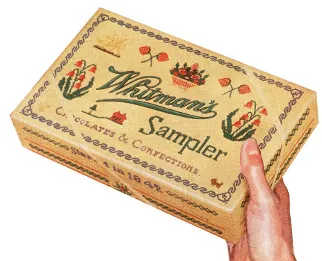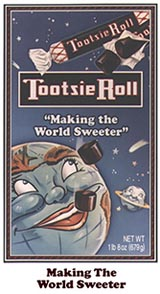SWEET
HISTORY
Although our characters, settings and plots may be
fictional, our historical western stories should remain true to important facts
in order to make them believable for our readers. Thus, when we authors do
research, obviously we check for dates of major events, inventions, the
founding of states, cities and towns and the famous and infamous who inhabited
them. But we also put emphasis in making sure the small historical things in
our stories are factual as well.
Where am I going with this? Well, in the historical western time-travel, YESTERYEAR’S DESTINY, (which BTW, I hope you all will check out!), the main character, Angela Moore chews Juicy Fruit Gum quite regularly. However, transported back in time to 1890, stores didn’t sell that brand yet. So, was chewing gum available then? And if so, what kind? For that matter, when she looked around the local general store, what other kinds of candy would she see? Could she pick up a Hershey’s chocolate bar? How about a Tootsie Roll?
Hence, my post on the American candy industry from the 1800’s forward.
The brand name of the gum Angela did chew was called Adam’s Black Jack Gum.
Thomas Adams
first created the chewing gum in his kitchen by boiling chicle, a natural tree
gum. In 1871, he received a patent on the popular gum and in 1884, he added
licorice flavoring, the first flavored gum in the U.S. It was also the first
gum to be offered in sticks.
Even though the history of candy-making dates back
thousands of years, as major advances in candy production developed, it became
a major industry. Penny candy in America could be easily produced and sold by
the pound, from glass jars in drugstores and general stores. As sugar prices
decreased, both home based candy makers and candy factories refined their
skills with candy brittles, taffy, caramels and simple hard candies.
However, it wasn’t until the latter 1800’s that candy
making became even more popular with the addition of an ingredient called
chocolate. Before this time, powdered chocolate was primarily used to create
hot chocolate as a drink. Chocolate became more popular with advances made to
offer chocolate as a solid, not just a powder. The ingredient could be molded
into a bar, used as a flavoring, as well as a coating. Milton Hershey was the
first American to bring the chocolate bar into mass production with machinery
he purchased from a German company.
Out of the hundreds of sweets that could be listed,
below is a timeline of some of the favorites I recognize. Many retro candies
and their founding companies have come and gone. However, a large percentage of
American candies have been around for more than a hundred years.
Hope you enjoy the journey through Sweet History..
1847
Oliver Chase invents a machine for cutting lozenges, which were made into
flavored candy wafers. Not until 1901 was NECCO Wafers introduced
by the company it was named after — New England Confectionery Company.
1848
John Curtis produces the first branded chewing gum, made from tree sap,
called The State of Maine Spruce Gum.
1854 The first packaged box of Whitman's Chocolate is produced.
1868 Richard Cadbury and the Heart-Shaped Box: The invention of the heart-shaped chocolate box by Richard Cadbury in the 19th century cemented the association of chocolate with Valentine's Day. These boxes were not just containers for chocolates; they were ornate and decorative, doubling as keepsakes.
1880s Wunderie Candy Company
creates candy corn, which remains a best-selling Halloween candy.
1893 Quaker City Confectionery Company, located outside Philadelphia, introduces Good & Plenty which becomes the oldest retro candy still in production.
1893 Milton
Hershey attends the World’s Colombian Exposition in Chicago and
watches chocolate being manufactured. Impressed, he purchases the German
equipment for his factory in Pennsylvania.
1893
William Wrigley, Jr. introduces Juicy Fruit Chewing Gum and Wrigley’s
Spearmint Chewing Gum
1894
Milton Hershey creates what is known as the first “American” candy bar,
although his famous Milk Chocolate Bar won’t be invented for a
few more years.
1896 Leo Hirshfield, New York confectioner,
introduces Tootsie Rolls, named after his daughter’s nickname,
Tootsie.

1900 Milton Hershey introduces a variation of what
will become the Hershey’s Milk Chocolate Bar.
1900 Clark Gum Company introduces Teaberry
Gum.
1901 Multicolored candy disks called NECCO
Wafers first appear.
1902 New England Confectionery Company makes the
first Conversation Hearts which remains a thriving Valentine’s
tradition.
1904 Emil Brach starts Brach’s Candy.
1906 The American Chicle Company, founded by Thomas
Adams, introduces Chiclets, the candy-coated gum that uses chicle
(derived from the sweet sap of a tropical tree and means chewing gum in
Spanish) inside.
1911 Ethel and Frank Mars open a candy company in
Tacoma, Washington. The company, later Mars, Inc., would become one
of the largest, privately owned candy companies in the entire world.
1912 Life Savers, reportedly named because
of their resemblance to life preservers, are introduced in peppermint flavor.
The five-flavor roll isn’t marketed for another 22 years.
1912 The Whitman's Sampler box of
chocolates debuts and is the first box of chocolates to include an index for
chocolate lovers to pick exactly which piece they want to eat.
1913 Goo Goo Clusters is introduced,
the first candy bar to combine milk chocolate, marshmallow, caramel, and
peanuts.
1914 The Heath Bar is introduced
by L.S. Heath & Sons.
1914 Mary Janes, a peanut-butter and
molasses flavored taffy-type candies are created by Charles N. Miller in
Boston, MA.
1916 George DeMet introduces the Turtle, a
chocolate covered caramel and nut candy that resemblances a real turtle.
Hope this post satisfied your “sweet tooth!”
Also, I sure hope you’ll check out my latest release,
Yesteryear’s Destiny, an adventure-filled time-travel, available at Amazon and
soon available at many more distributors.
Please visit
my web site - click here.
Amazon author page - click here

















